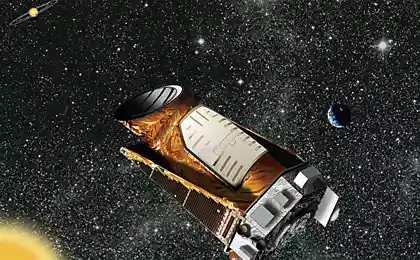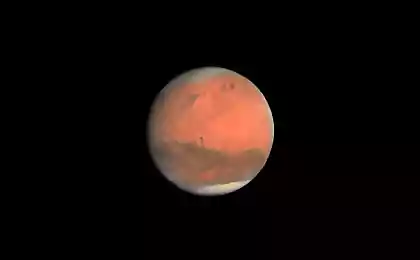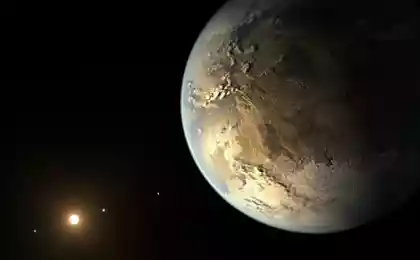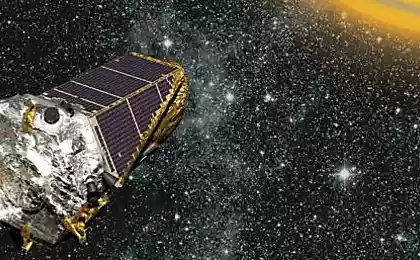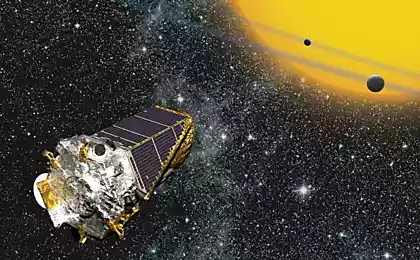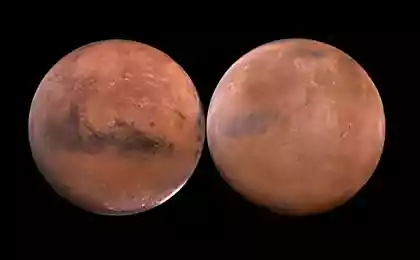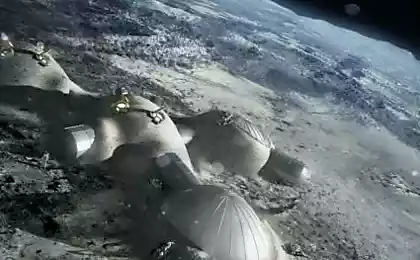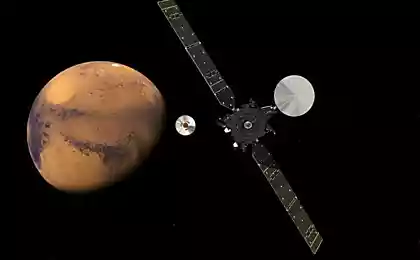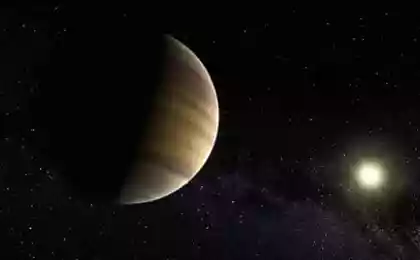949
Astronomers have found one of the smallest exoplanets having a size of Mars
Planet Kepler at number-138b was discovered by astronomers Pennsylvania State University in the processing of Information received from the telescope "Kepler." The planet was not only a small (radius of half the earth), but surprisingly light - just 6.7% of the mass of the Earth. It is the lightest exoplanet orbiting an ordinary star of the discovered.
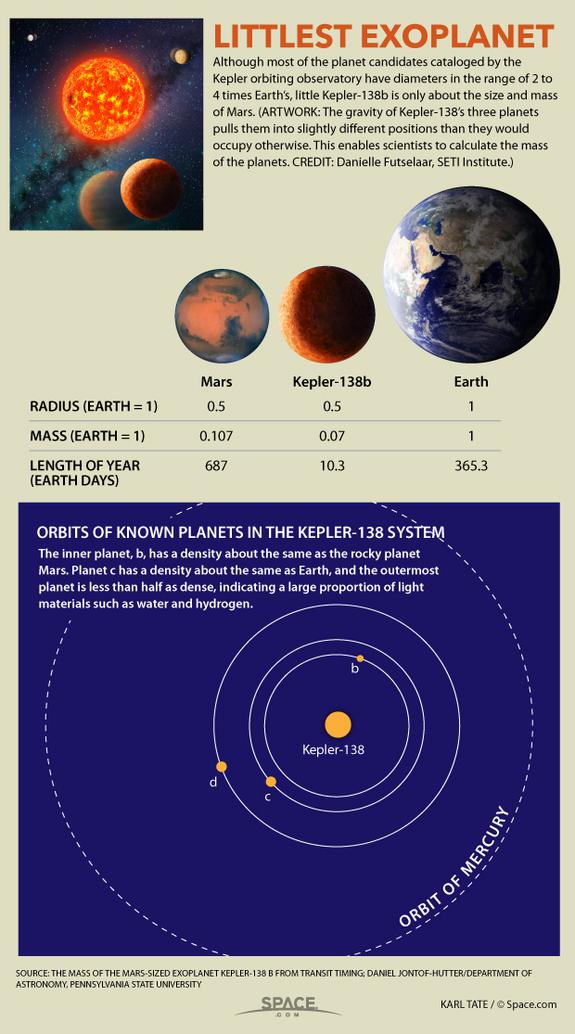
Smartly planet orbiting the star Kepler-138, making a complete revolution a little more than 10 Earth days. The star is located 200 light-years from Earth in the constellation Lyra. Kepler-138b - the closest planet to the star in his system. With dimensions comparable to Mars, it weighs a third less than it, which indicates its composition predominantly rocky.
The star has two more planets. 138c has a density comparable to that of the earth, and twice its heavier. 138d twice as thick and at least one third lighter than the earth - that is possibly on it predominates liquid or gases. Circulation period of the first planet around the star is 14 of our days, and the second - for 23 days. Since all of these planets are much closer to its star than our Mercury - the Sun, the more likely they are very hot and they do not have water in liquid form. The surface temperature of the outer planet estimated at 120 degrees Celsius, and on the inside - 320 degrees.
"The huge diversity of exoplanets discovered" Kepler ", it says that the system like ours are not the norm in space - and we do not know why this is so, - says study author Daniel Dzhontof-Hutter, an astronomer at the University. - Further analysis will tell you how planets form and give an understanding of how often encountered in space systems like ours ».
"Kepler" transit method looks for exoplanets - it tracks changes in luminosity of the star at the time of the passage of a planet on its background. This way you can find a sufficiently large planets, and then only such an orbit that lies in the same plane as the point of observation. The smallest of the detected extrasolar planets to date is PSR B1257 + 12 b, has a mass of about 2% of the earth. However, it revolves around a pulsar - a dense, rapidly rotating body, left over from a supernova explosion.
Today reliably confirmed the existence of 1,931 exoplanet in 1222 planetary systems. Number of candidates for extrasolar planets much more - a telescope Kepler counted more than 4 thousand. These candidates will have to check with the help of ground-based telescopes.
The total number of exoplanets in our galaxy is estimated at least $ 100 billion, of which 5 to 20 billion could be "Earth-like". About 34 percent of sun-like stars have a planet in the habitable zone, comparable to Earth.
The vast majority of exoplanets discovered open using various indirect methods. Most of the known extrasolar planets - gas giants, and more like Jupiter than to Earth, because such big planets are easier to detect with the help of modern methods.
Telescope "Kepler" was originally designed to search for exoplanets. It was launched in March 2009 and in May 2013 failed. After the failure of flywheels accurate orientation unit has become impossible, but analysis of the data will continue for several years.
Source: geektimes.ru/post/252176/

Smartly planet orbiting the star Kepler-138, making a complete revolution a little more than 10 Earth days. The star is located 200 light-years from Earth in the constellation Lyra. Kepler-138b - the closest planet to the star in his system. With dimensions comparable to Mars, it weighs a third less than it, which indicates its composition predominantly rocky.
The star has two more planets. 138c has a density comparable to that of the earth, and twice its heavier. 138d twice as thick and at least one third lighter than the earth - that is possibly on it predominates liquid or gases. Circulation period of the first planet around the star is 14 of our days, and the second - for 23 days. Since all of these planets are much closer to its star than our Mercury - the Sun, the more likely they are very hot and they do not have water in liquid form. The surface temperature of the outer planet estimated at 120 degrees Celsius, and on the inside - 320 degrees.
"The huge diversity of exoplanets discovered" Kepler ", it says that the system like ours are not the norm in space - and we do not know why this is so, - says study author Daniel Dzhontof-Hutter, an astronomer at the University. - Further analysis will tell you how planets form and give an understanding of how often encountered in space systems like ours ».
"Kepler" transit method looks for exoplanets - it tracks changes in luminosity of the star at the time of the passage of a planet on its background. This way you can find a sufficiently large planets, and then only such an orbit that lies in the same plane as the point of observation. The smallest of the detected extrasolar planets to date is PSR B1257 + 12 b, has a mass of about 2% of the earth. However, it revolves around a pulsar - a dense, rapidly rotating body, left over from a supernova explosion.
Today reliably confirmed the existence of 1,931 exoplanet in 1222 planetary systems. Number of candidates for extrasolar planets much more - a telescope Kepler counted more than 4 thousand. These candidates will have to check with the help of ground-based telescopes.
The total number of exoplanets in our galaxy is estimated at least $ 100 billion, of which 5 to 20 billion could be "Earth-like". About 34 percent of sun-like stars have a planet in the habitable zone, comparable to Earth.
The vast majority of exoplanets discovered open using various indirect methods. Most of the known extrasolar planets - gas giants, and more like Jupiter than to Earth, because such big planets are easier to detect with the help of modern methods.
Telescope "Kepler" was originally designed to search for exoplanets. It was launched in March 2009 and in May 2013 failed. After the failure of flywheels accurate orientation unit has become impossible, but analysis of the data will continue for several years.
Source: geektimes.ru/post/252176/
Land Rover made a prototype car with a remote control from your smartphone
10 humanoid robots created in the likeness of human abilities and emotions





